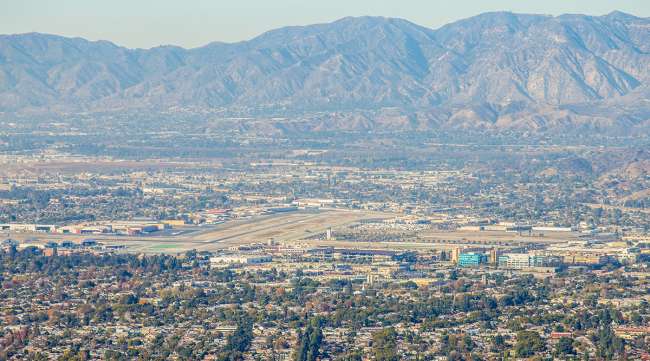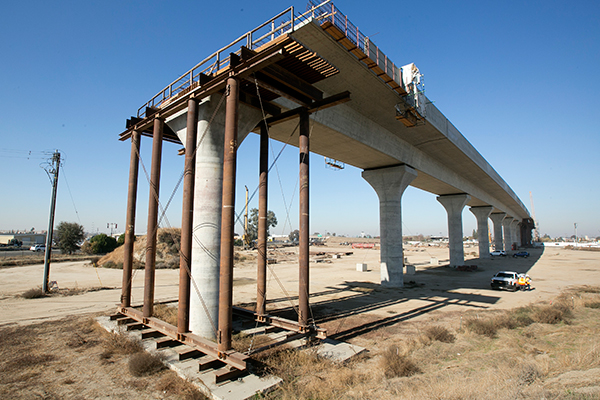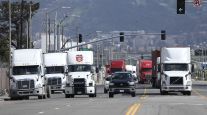Los Angeles Times
Tunnel Planned for California Bullet Train Under Burbank Airport

[Stay on top of transportation news: Get TTNews in your inbox.]
The complexity of building a bullet train through Southern California’s urban maze is leading state officials to consider two major additions: a tunnel under the Burbank airport and a project that would help a freight railroad expand its switching yards in the Inland Empire.
Engineering studies reveal potential complications in the $80 billion project that have yet to be fully understood, even as the California High-Speed Rail Authority struggles to complete 119 miles of construction in the Central Valley that is over budget and behind schedule.
In a September review of its Central Valley work, obtained by The Times and marked “confidential,” the rail authority listed the Burbank airport station as a program risk that could delay the completion of environmental reports by three to six months. It could also delay a freight train impact analysis for the Los Angeles-to-Anaheim segment by three to six months and calculations for estimated bullet train trip times across the system by six to 18 months.

Newsom
Studying a Burbank airport tunnel may be academic, since the state doesn’t have the money to build the Southern California section of the bullet train, part of a roughly $50 billion to $60 billion shortfall in the project’s funding. Gov. Gavin Newsom has pledged his support to building a 171-mile subsystem in the Central Valley between Merced and Bakersfield.
But despite those hurdles, California must proceed with design of the system. The project must complete all of its environmental documents, which include the train’s exact route, by 2022 — forcing the rail authority to make early decisions about designs that may not be built for years or even decades. If it fails to meet that deadline, federal regulators could demand repayment of about $2.5 billion in grant money.
At the same time, the rail authority must comply with tough state design requirements. Any violations could prompt a lawsuit that challenges the legality of the entire project.
The consideration of a tunnel under the Burbank airport could help the rail authority comply with speed and trip time requirements set in state law.
Frank Miller, executive director of the Burbank-Glendale-Pasadena Airport Authority, said the agency has had recent discussions with the state about the tunnel.
“If they want to go under the runway, we need to have some discussions about how that would work,” he said. “There are some issues with takeoffs and landings. It would have to be put in place in such a way that we wouldn’t have any issues with the Federal Aviation Administration.”
The rail authority announced a plan in 2018 to align the rail from Palmdale to Burbank along Highway 14. The 38-mile route would traverse the San Gabriel Mountains via five separate tunnels, numerous bridges and various at-grade sections.
The route was determined to be easier to construct and cause less harm than two other alternatives, though it is somewhat longer.
That longer route, along with curves and other features, has raised concerns about adding trip time on the Burbank-to-Palmdale segment, according to a project official who was not authorized to comment publicly.
If so, it complicates the train’s compliance with state mandates that it be designed to run from Los Angeles to San Francisco in no more than 2 hours and 40 minutes, the person said.
The rail authority said in a statement that the 2018 decision to use the Highway 14 route included an option for an underground station at the Burbank airport.
“Our trip times are required by law,” spokeswoman Annie Parker said. “As the environmental documents in the north and the south continue to be finalized, we will continue analysis and refinements required to ensure that high-speed rail meets them.”

One of the elevated sections of the high-speed rail under construction in Fresno, Calif., on Dec. 6, 2017. (Rich Pedroncelli/Associated Press)
The bullet train was originally envisioned to run at 220 mph along nearly its entire passage, but over the last decade, a series of compromises with local communities and design changes to save money have created slower sections.
The rail authority said in summer 2018 that it could still meet the trip-time legal requirements in a simulation that it conducted, but with only a margin of three minutes and 10 seconds — assuming nearly perfect track conditions and flawless human train operator performance. The simulation was done before the adoption of the Highway 14 route and other decisions. Every minute counts and a tunnel could help preserve the required schedule.
The conundrum of designing a costly tunnel to save seconds or minutes goes to the heart of a long-held complaint about the project: The 2008 rail bond act approved by voters prevents engineers from making compromises, even in the face of budget shortfalls.
The future bullet train station at the airport would be jammed in a tight corner, lying among airport property, Hollywood Way and the 5 Freeway. It would potentially affect residential neighborhoods, commercial developments and the airport.
Miller said the rail authority is discussing going under Runway 826, the east-west runway at the airport.
“It can be done,” he said. The airport’s overriding issue is that the train station be within easy walking distance of a new passenger terminal at the airport, he said.
The other complication involves BNSF Railway, which owns the right of way from Los Angeles to Anaheim that the high-speed rail would utilize for some of its new track.
The railroad is concerned about impacts on its freight movements along the heavily used corridor and told the rail authority that it might need to expand its switching yards in Barstow and the Inland Empire to accommodate the additional traffic.
The rail authority has begun a pre-environmental assessment of the plan that BNSF requested, according to a high-speed rail official who was not authorized to speak publicly.
A rail authority spokeswoman acknowledged the study, saying the authority is working with BNSF to environmentally clear the Los Angeles-to-Anaheim section.
BNSF owns a portion of the track between Los Angeles and Anaheim, which the rail authority is analyzing, said company spokeswoman Lena Kent, who added that BNSF has long sought to balance the needs of passenger service with the safety and efficiency of its own operations.
“The California High-Speed Rail Authority is analyzing how to continue to achieve this mutual goal here in Southern California in coordination with BNSF,” she said.
An expansion of the rail yards could require property acquisitions, triggering a complex environmental assessment and possible local opposition, according to the rail authority official who spoke on background.
The study could involve a variety of agencies, including San Bernardino County, the San Bernardino Transportation Authority, and the cities of Barstow and Colton.
Want more news? Listen to today's daily briefing:
Distributed by Tribune Content Agency, LLC




